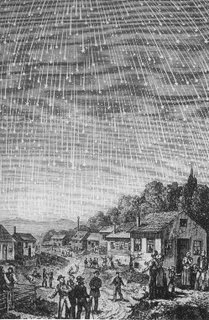The annual Leonid meteor shower could produce a strong outburst this weekend for residents of eastern North America and Western Europe (For our Belgian reader).
A brief surge of activity is expected begin around 11:45 p.m. ET Saturday, Nov. 18. In Belgium, that corresponds to early Sunday morning, Nov. 19 at 4:45 GMT. The outburst could last up to two hours.
At the peak, people in these favorable locations could see up to 150 shooting stars per hour, or more than two per minute.
"We expect an outburst of more than 100 Leonids per hour," said Bill Cooke, the head of NASA's Meteoroid Environment Office. Cooke notes that the shooting stars during this peak period are likely to be faint, however, created by very small meteoroid grains.
 The Leonids are bits of debris left behind by repeated passages through the inner solar system of the comet Tempel-Tuttle. Each November, Earth crosses various trails of debris, which have spread out over centuries and millennia.
The Leonids are bits of debris left behind by repeated passages through the inner solar system of the comet Tempel-Tuttle. Each November, Earth crosses various trails of debris, which have spread out over centuries and millennia.The Leonids are so-named because they appear to emanate from Leo. The meteors can race across the sky in any direction, but trace each one back and it'll point to Leo.
The Leonids are actually underway already, ramping up gradually to the peak. The event continues for several days after the peak. So any morning during this time could offer up a handful of meteors each hour. Other shooting stars from other sources typically grace the sky at low rates, too.
Flurries of enhanced activity can come at any time. Cooke suggests taking a look in the pre-dawn hours Friday, Saturday and Sunday. Up to 10 shooting stars per hour are possible any of these mornings.
How to watch
Precise prediction of meteor showers is an infant science, so those in position to observe the possible outburst should plan to head out a half-hour before the predicted peak, allowing eyes time to adjust to the dark, and stay out for up to a half hour after the expected peak.
No special equipment is needed. Telescopes and binoculars are of no use.
A lounge chair or blanket and warm clothes are all you need [meteor watching tips]. Find a dark location with a clear view of the Eastern horizon. Lie back, face East, and scan as much of the sky as you can . You never know exactly where a Leonid will appear.
No comments:
Post a Comment